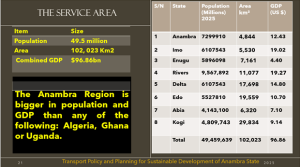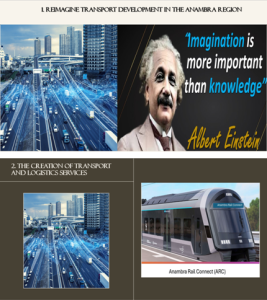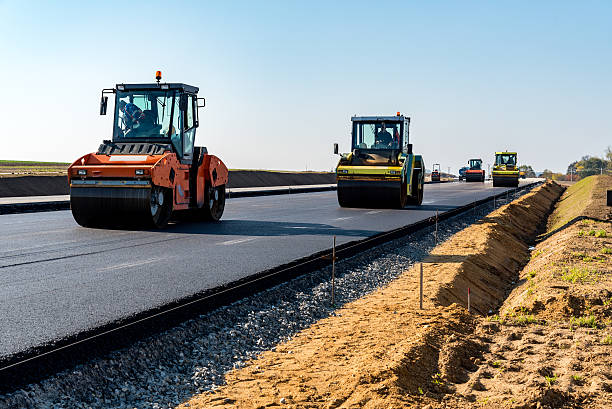
Dr. Alban Igwe: Championing Smart Transport Policy for a Thriving Services Economy
- Resources
- April 27, 2025
- No Comment
- 81
In a compelling presentation at the Anambra Ministry of Transport’s Policy Retreat held from March 26–28, 2025, Dr. Alban Igwe, LLM, FCILT, laid out a visionary framework for repositioning Anambra State through strategic transport policy and planning. With a distinguished background in law, logistics, and infrastructure, Dr. Igwe brought clarity to the pivotal role of transportation in accelerating economic growth—particularly within a services-driven economy.
A Fellow of the Chartered Institute of Logistics and Transport (CILT), Dr. Igwe is known for blending policy insight with practical strategy. His call to action was clear: for Anambra to fully unlock the potential of its services economy, it must view transport infrastructure not as a cost, but as a catalyst for inclusive development and long-term sustainability.
The Services sector accounts for over 70% of global GDP and over57% of Nigeria’s GDP.
The transition from a manufacturing-focused to a service-oriented economy began in the mid-20th century.
Transport, logistics and supply chain are key elements in services sector and currently the world Bank’s Logistics Performance Index (LPI) is a key metric for measuring international competitiveness.
So given the critical role of transport, logistics and supply chain, crafting an intentional transport policy and masterplan represents a strategic development agenda.
The nexus between Transport and Sustainable development
The United Nations has set the Sustainable Development Agenda 2030 with seventeen goals and targets to drive development in the 21st century. Even before the Agenda 2030, several attempts have been made towards achieving sustainable development beginning from Agenda 21, adopted at the 1992 Earth Summit in Rio de Janeiro. It should be noted that the transport strategy can be used to achieve most of our development objectives. For example, the greatest tool for combating food insecurity is not increasing food production (since the world produces more food than we need) but reducing food losses and food waste which is a supply chain (transport) strategy.
Sustainable transportation, as defined by the United Nations, is “the provision of services and infrastructure for the mobility of people and goods — advancing economic and social development to benefit today’s and future generations — in a manner that is safe, affordable, accessible, and environmentally responsible”.
Transport-Oriented Development (TOD)
The United Nations recognizes the central role of transportation and mobility in ensuring sustainable development. Transport-Oriented Development (TOD) is crucial for achieving multiple Sustainable Development Goals (SDGs), particularly by fostering sustainable cities (SDG 11), promoting economic growth (SDG 8), and reducing environmental impact (SDG 13) through efficient and sustainable transportation systems. A cursory look at the SDGs reveals the role of transport in achieving the SDGs.
- Sustainable Cities and Communities (SDG 11)
Access to Safe and Affordable Transport: TOD prioritizes public transport, walking, and cycling, making transportation accessible and affordable for all, especially vulnerable populations.
Reducing Congestion and Pollution: By promoting efficient and sustainable transportation, TOD helps reduce traffic congestion and air pollution, improving the quality of life in urban areas.
Inclusive Urbanization: TOD promotes inclusive and sustainable urbanization by ensuring that transportation infrastructure caters to the needs of all residents, including people with disabilities and low-income individuals.
- 2. Decent Work and Economic Growth (SDG 8)
Economic Growth: TOD can stimulate economic growth by improving accessibility to employment centers, markets, and other economic opportunities.
Job Creation: The development and maintenance of transportation infrastructure can create jobs in various sectors, including construction, engineering, and transportation services.
Sustainable Industrialization: TOD can support sustainable industrialization by facilitating the movement of goods and services, promoting regional integration, and enhancing access to markets.
Good Health and Well-being (SDG 3)
TOD can improve public health by reducing air pollution and promoting active transportation, which can lead to better physical health and well-being.
Target 3.6: By 2030, halve global deaths from road traffic accidents.
Industry, Innovation, and Infrastructure (SDG 9)
TOD fosters innovation in transportation technologies and infrastructure, promoting sustainable and resilient transportation systems.
Target 9.1: Develop resilient infrastructure, improve infrastructure quality, and promote sustainable and inclusive industrialization.
Reduced Inequalities (SDG 10)
TOD can help reduce inequalities by ensuring that all residents have access to affordable and accessible transportation, regardless of their income or location.
Target 11.2
By 2030, provide access to safe, affordable, accessible and sustainable transport systems for all, improving road safety, notably by expanding public transport, with special attention to the needs of those in vulnerable situations, women, children, persons with disabilities and older persons.
- Climate Action (SDG 13)
Reducing Greenhouse Gas Emissions: By promoting sustainable modes of transport, TOD can significantly reduce greenhouse gas emissions from the transportation sector, contributing to climate action.
Energy Efficiency: TOD encourages the use of energy-efficient modes of transport and technologies, helping to reduce energy consumption and promote a low-carbon economy.
Dubai performance
In 2023, Dubai’s Roads and Transport Authority (RTA) generated AED 3.7 billion in revenue.
Singapore’s public transport operator SBS Transit on Tuesday (Feb 25) reported a 2.1 per cent increase in group revenue to S$1.56 billion (US$1.17 billion) for 2024.
In 2023, ordinary revenue from passenger transport in the Netherlands increased by 22% to €2.887 billion. The Netherlands is expected to see a significant growth in revenue within the Public Transportation market, with a projected revenue of US$4.85bn (about N7trn) in 2025.

Policy Vs Planning
Policies are frequently, though not exclusively, incorporated into laws and other legal instruments that serve as a framework for developing planning interventions. Planning does not necessarily involve legislative action and is more focused on the means of achieving a particular goal, often within the existing regulatory framework. Policy dictates while planning implements.
Transport as a service (TaaS)
Transportation as a Service (TaaS) is a subscription-based business model offering comprehensive transportation solutions, including vehicles, insurance, maintenance, charging infrastructure, etc aimed at providing predictable, flexible and cost –efficient services. In a service driven economy, transport is key
Public Transport Performance in the uk
In the UK, public transport revenue, including bus, rail, and tram services, reached approximately £10.3 billion in 2023/24, with bus services generating around £3.5 billion in passenger revenue alone.
A glimpse at Public Transport Performance in the uk2
Passenger revenue on local bus services = £3.5 billion 2022/23.
Total estimated operating revenue for local bus services in England, for the year ending March 2023 = £5.5 billion.
Public funding accounts for 44% of all bus industry income in England, with the rest coming from fares.
National Rail: National rail passenger fare income = £10.3 billion in 2023/24
Public Transport Performance in Singapore
Singapore, a tiny island nation with population of 5.918 million (2023), is now a global logistics powerhouse.
Geographic Advantage: Singapore’s geographical location is a linchpin in its logistics success.
World-Class Infrastructure: The Port of Singapore and the upcoming Tuas Mega Port are technological marvels with cutting edge infrastructure.
Technological Innovations: Singapore has embraced technological innovations, transforming its logistics landscape and optimizing supply chain operations.
Singapore is the world’s busiest container trans-shipment hub. By the 2040s, Tuas Port is projected to become the largest fully automated port, with an annual handling capacity of 65 million twenty-foot equivalent units (TEUs), capable of managing the largest container ships and complex cargo operations.
A cursory look at Singapore
Singapore is a leading global logistics hub due to its strategic location, world-class infrastructure, and business-friendly environment, consistently ranked among the top logistics hubs globally. It’s home to the world’s busiest transshipment seaport and one of Asia’s largest cargo airports, facilitating efficient global trade and connectivity.
Recommendations

CONCLUSION
Anambra State by virtue of geographic location is a logistics hub for Southern Nigeria. Therefore, strategic development of her transport system represents a new market and a new economy and the time to exploit it is now.


